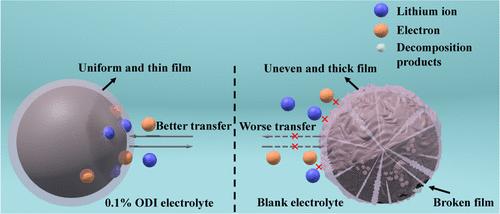用1,1′-草酰二咪唑(ODI)添加剂构建坚固界面以提高LiNi0.8Co0.1Mn0.1O2/石墨电池的温度和倍率性能
IF 8.2
2区 材料科学
Q1 MATERIALS SCIENCE, MULTIDISCIPLINARY
引用次数: 0
摘要
本文研制了1,1′-草酰二咪唑(ODI)作为功能性电解质添加剂。该成膜添加剂改善了LiNi0.8Co0.1Mn0.1O2/石墨(NCM811)电池的宽温度范围和速率性能。在室温(25℃)下循环1200次后,空白电解液电池的放电容量保持率为51.95%,含odi电解液电池的放电容量保持率为93.18%。当ODI为0.1%时,45℃下500次循环后放电容量保持率从0提高到75.89%,−10℃下300次循环后放电容量保持率从48.51%提高到95.54%。此外,0.1% ODI的引入也提高了速率性能。通过光谱表征,支持ODI对电池电化学性能的改善。结果表明,ODI倾向于优先在电极上分解,进而参与构建稳定的低阻抗界面膜,从而提高电池性能。这项工作不仅开发了一种以咪唑为基础的电解质,而且还激发了创造功能性添加剂的创新方法,可以提高电池的性能。本文章由计算机程序翻译,如有差异,请以英文原文为准。

Constructing a Robust Interphase with 1,1′-Oxalyldiimidazole (ODI) Additive to Enhance the Temperature and Rate Performance of LiNi0.8Co0.1Mn0.1O2/Graphite Batteries
This work develops 1,1′-oxalyldiimidazole (ODI) as a functional electrolyte additive. This film-forming additive improves the wide range of temperature and rate performances of LiNi0.8Co0.1Mn0.1O2/graphite (NCM811) batteries. After 1200 cycles at room temperature (25 °C), the discharge capacity retention rate is 51.95% for the battery with a blank electrolyte, and it is 93.18% for that with an ODI-containing electrolyte. With 0.1% ODI, the discharge capacity retention increases from 0 to 75.89% after 500 cycles at 45 °C and increases from 48.51 to 95.54% after 300 cycles at −10 °C. In addition, the rate performance is also enhanced by the introduction of 0.1% ODI. With spectroscopic characterization, the improvement of battery electrochemical performance by ODI is supported. It is demonstrated that ODI tends to preferentially decompose on the electrodes and then participates in the construction of a stable interfacial film with low impedance, resulting in the improvement of battery performance. Not only does this work develop an imidazole-based electrolyte, but it also inspires innovative approaches to creating functional additives that can enhance battery performance.
求助全文
通过发布文献求助,成功后即可免费获取论文全文。
去求助
来源期刊

ACS Applied Materials & Interfaces
工程技术-材料科学:综合
CiteScore
16.00
自引率
6.30%
发文量
4978
审稿时长
1.8 months
期刊介绍:
ACS Applied Materials & Interfaces is a leading interdisciplinary journal that brings together chemists, engineers, physicists, and biologists to explore the development and utilization of newly-discovered materials and interfacial processes for specific applications. Our journal has experienced remarkable growth since its establishment in 2009, both in terms of the number of articles published and the impact of the research showcased. We are proud to foster a truly global community, with the majority of published articles originating from outside the United States, reflecting the rapid growth of applied research worldwide.
 求助内容:
求助内容: 应助结果提醒方式:
应助结果提醒方式:


